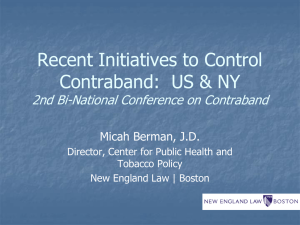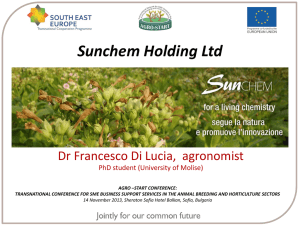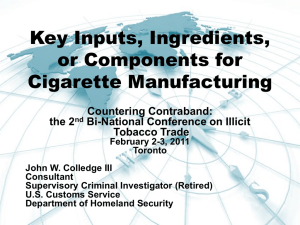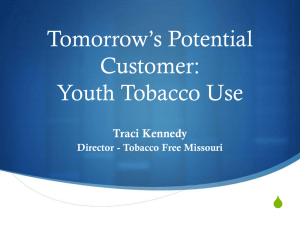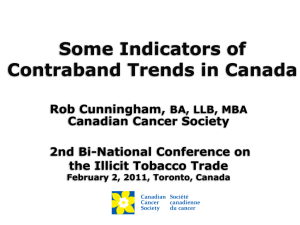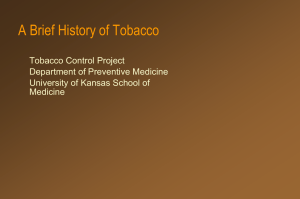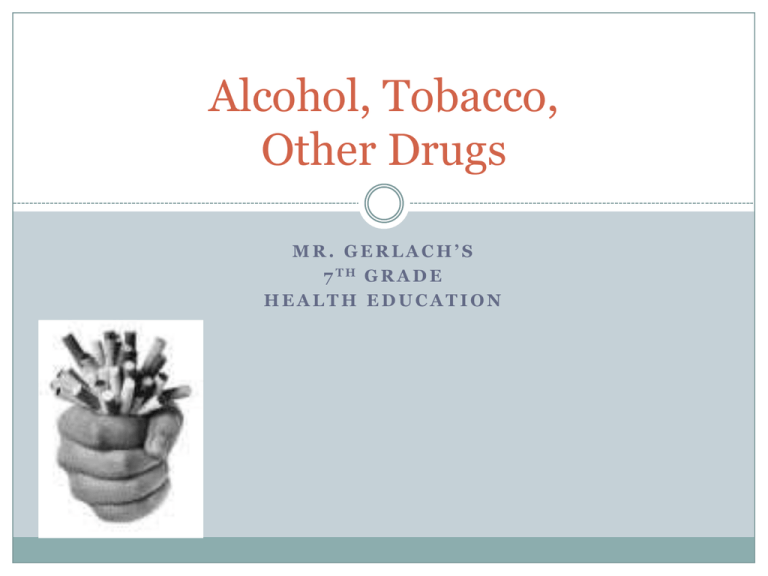
Alcohol, Tobacco,
Other Drugs
MR. GERLACH’S
7 TH G R A D E
HEALTH EDUCATION
Alcohol
Defn: Alcohol is a drug
that is produced by a
chemical reaction in
fruits, vegetables, and
grains.
Depressant: A drug
that slows down the
working of the brain and
other parts of the
Nervous System
Alcohol is a Depressant
1.78 Million youths in the United States between the ages
of 12-20 have drinking problems
Facts
Myths
70 % of all adults drink alcohol
Alcohol does not make a person
1/3 of adults don’t drink at all
Over 17 million people have
physical, social, and
psychological problems with
alcohol
Over 95,000 alcohol related
deaths each year.
Teenagers cannot consume
alcohol
Legal age for alcohol
consumption is 21 years of age.
smart, cute, sexy, powerful,
tough, rich.
Drinking alcohol is not an
effective way of coping with
one’s problems; in fact, it just
adds to them.
Being able to hold one’s liquor
has nothing to do with being
cool or tough.
Drinking alcohol does not help
a person to sleep better.
Alcohol and the Individual
Effects of Alcohol on a person has a number of
factors
Speed- Rate at which you consume the alcohol
Quantity- Number of alcoholic beverages
Food- Whether or not you have eaten
Weight- Your weight
Gender- Male or female
Mood- A drinker who starts off depressed usually ends
up more depressed
Other drugs- Mixing alcohol with other drugs increases
the effects of alcohol.
Alcohol Content of Beverages
No alcohol drink is a
safe Drink !!!
BAC ( Blood Alcohol
Concentration) – The
amount of alcohol in a
person blood
BAC and Traffic Accidents
What is Binge Drinking?
Binge Drinking- Five drinks in a row for males, 4 for females.
Frequent binge drinkers are more likely to:
Miss classes and get behind in school work
Argue with friends
Engage in unplanned or unprotected sex
Drive after drinking
Get into trouble with campus police
Damage property
Get hurt or injured 12
Problems Associated with Alcohol
FAS ( Fetal Alcohol
Syndrome) – A group of
alcohol-related birth
defects that may include
both physical and mental
problems.
Drinking and Driving
Short-Term Effects of Alcohol
Long-Term Effects of Alcohol
Alcohol and Teens
Some sobering statistics for teens.
Alcoholism
Defn: The physical and
mental need for alcohol
turns into a progressive
and chronic disease.
Alcoholics have two
needs.
1. Physical- The body
feels a direct need for
alcohol
2. Psychological- The
mind sends the body
the message that it
needs more and more
alcohol
How YOU can Help.
1.
2.
3.
4.
5.
What to do !!
Talk calmly with the
drinker about the effects
of alcohol.
Tell the drinker how
concerned you are
Help the drinker to feel
good about quitting
Give the drinker
information about
groups that can help
Encourage the drinker to
get help
1.
2.
3.
4.
What not to do !!
Do not argue with the
person
Do not make excuses to
other’s for the drinker’s
problem
Do not feel that you are
responsible for the
drinker’s action
Do not be afraid to seek
help for that person if he
or she won’t.
Choosing to be Alcohol Free !!
Why Some People Drink
“All my friends drink”
“Alcohol makes me look grown-up”
“Alcohol helps me forget about my problems”
“Alcohol help me to relax”
“Alcohol helps me feel less shy around other people”
Some Reasons Not to Drink !!
1.
2.
3.
4.
5.
6.
7.
It is ILLEGAL
It gets in the way –
Sports
It is not fun
It is not smart
It does not solve
problems
It disappoints others
and makes the user feel
guilty
It harms your health
Other Things to Do
Talk about other things
to do
Tobacco
MR. GERLACH’S
7 TH G R A D E
HEALTH EDUCATION
Smoking trends by High School Students
What is Tobacco?
Tobacco is a plant grown in the United States, China,
Brazil and India among other countries. The leaves
of tobacco plants are dried, aged for two years, and
then used to make cigarettes, cigars, pipe tobacco
and snuff.
Chemicals in Tobacco
Questions to Ask Yourself
Would you pour nail polish remover (Acetone) over your
cereal in the morning, or brush your teeth with mascara
(Stearic Acid) ? Of course not!
Would you use shaving cream (ethanol)
in place of whipped cream on a piece of pie? Nope!
Yet, when you use tobacco, you are taking these chemicals
into your body!
There are over 4,000 chemicals in tobacco.
200 of them are heavy metals like cadimum (which is used
to make batteries).
Why People Smoke
Nicotine addiction - addiction can start a few
days after have a few cigarettes. Half of teenagers
progress to daily smoking, and become addicted
Social and psychological factors- physical
addiction, and habits (using tobacco in social
situations), character
Why start in the first place?-- appear older,
mature, cool, manly, parents smoke do not
discourage smoking.
Who uses tobacco?- 90% of new smokers are
children and teens, average age is 13.
Tar – A dark, thick, sticky liquid that forms when
tobacco burns.
1 pack of Cigarette
=
1 Quart of Tar in the lungs
over a lifetime
Nicotine – An addictive
drug that is found in all
tobacco products.
Carbon monoxide – A
colorless, odorless,
poisonous gas that is
produced when tobacco
burns.
A Cigarette in Action !!!
Different Forms of Tobacco
Cigarette – The most common
form in which tobacco is used.
Cigars and Pipes – Cigars and
Pipes produce more tar than
cigarettes. Cigar smokers are
more likely to develop cancers.
Smokeless Tobacco – Chew is
made from coarsely ground
tobacco leaves. Users suck and
occasionally chew on it.
How Tobacco Affects the Body Systems
Tobacco Affects the Body System
How Tobacco Affects the Body
Personal
Appearance
Stained Teeth
Stained fingers
Clothing damage
Bloodshot eyes
Wrinkles
Smelly clothes
Bad breath
The Cost of Tobacco
# of Packs
Cost/Month
Cost/Year
1 Pack a Day
$98.51
$1,182.09
1.5 Packs a
Day
2 Packs a Day
$147.76
$1,773.14
$197.02
$2,364.18
$3.25 Per Pack
Lifetime cost = 60 years = $141,850.80
The Cost of Tobacco
Packs/ Day
Cost/ Month
Cost/ year
1
$127.30
$1527.60
1.5
$190.95
$2291.44
$254.60
$3055.22
2
$4.20
Per Pack
Lifetime Cost = $183,313.20
Hidden Cigarette Costs
Clothes ruined from cigarette smoke or cigarette
burns.
Higher Insurance Rates
Doctor or Dental bills from Smoking
Tobacco Addictions
Addiction – A physical or
mental need for a drug or
other substance.
Nicotine is as addictive
as heroin, cocaine and
alcohol
Tobacco is the most
common form of drug
addiction in the United
States.
Choose to BE Tobacco FREE
Why Teens Start to use Tobacco
A False Crutch:
Peer Pressure
Control Weight
Look cool
Stress
Parents smoke
Using Lighters / Carrying Cigarettes
Loss of Control
• 75% of tobacco addicts SAY want to
quit
• 60-80% of addicts quit at stop-smoking
clinics, but nearly all relapse tobacco
addicts have dysfunctional need
gratification cycle
average 40 minutes between nicotine fix
(get edgy, irritable, trouble
concentrating if no drug)
It’s not to late to Quit
Tobacco In The Media !!
Gives false impressions of
people who smoke
Images
Athletic
Healthy Rebels
Mature
Attractive
The Reality of SMOKING!!
Reality
Sickly
Constantly Short of Breath
Social outcasts
Prematurely Aged
The Truth!
Other Illegal Drugs
MR. GERLACH’S
7 TH G R A D E
HEALTH EDUCATION
Over-The-Counter Drugs
Drugs – Substances
other than food that
change the structure or
function of the mind.
Medicines –Drugs that
are used to treat or
prevent diseases and
other conditions.
Over-the-counter Drugs
Medicines that prevent
disease:
Vaccines prevent diseases
Ex. You should be
vaccinated for:
Tetanus
Measles
Mumps
Rubella
Hepatitis B
Influenza
Over-the-counter Drugs
Medicines that fight
disease:
Antibiotics: Medicines
that reduce or prevent
harmful bacteria in the
body.
Most antibiotics are
received after a visit to the
doctor.
Over-the-counter Drugs
Medicines that provide
relief:
These medicines provide
relief from headaches,
toothaches and muscular
pain.
How Medicines Enter the body
Reaction to Medicines
Tolerance – A person’s body becomes used to the
effect of a medicine and needs greater amounts of it
to be effective.
Side effect – Any reaction to a medicine other than
the one intended.
Ex.
Upset Stomach
Dizziness
Drowsiness
Two Categories of Drugs
1.
Stimulants – Drugs that speed up the body’s
functions.
Effects of Stimulants on the Body
- Speed up the central nervous system
- Cause your heart rate to increase
- Cause respiratory rates to increase
- Cause high blood pressure
Stimulants
Caffeine – A mild stimulant found in coffee, pop, and
tea.
Harsh Stimulants used to get “HIGH”
Two Categories of Drugs
2. Depressants – Drugs
that slow down the
body’s functions and
reactions.
Tranquilizers
BARBITUATES
Rock
Ice / Crystal Meth
Tablets
Powder
Facts on Meth
Meth stimulates the central nervous system and has a high potential for
abuse and dependence.
Methamphetamine street names: Meth, Crystal Meth, Crystal, Ice, Crank,
Speed, Glass, & Chalk.
It can be smoked, injected intravenously, snorted or eaten. The user
experiences an intense "rush" lasting only a few minutes when smoked or
injected.
The only medical treatment this drug is used in is for obesity, but very
limited otherwise.
Meth in the United States
How Meth Works in the Body
Meth and the Brain
Negative Effects of Meth
Hyperactivity
Weight loss, malnutrition,
Irritability
Aggression
Suspiciousness
Severe Paranoia
Shortness of breath
Sweating
Nausea, Vomiting,
Diarrhea
Long period of sleep (for
24-48 hrs or more)
Severe depression,
Sluggishness
anorexia
Itching (feeling that bugs
are crawling on your skin)
Welts on the skin (crank
bugs)
Uncontrollable body and
facial twitches, grimacing
Paranoid delusions
Visual hallucinations
Auditory hallucinations
(hearing "voices")
Suicidal tendencies
Methamphetamines
Meth Lab Components
Suphedrine tablets and matches
used in manufacturing.
Rubbing Alcohol
Cold Medicine Containing
Pseudoephedrine or Ephedrine
Matches (Red Phosphorus)
Salt
Gasoline additives
Gasoline
Pool acid/ Muratic acid
Drain cleaner (e.g. "Red Devil lye")
Acetone
Iodine
Brake Fluid Brake Cleaner
Iodine Crystals
Lithium Metal / Lithium Batteries
Lighter Fluid
Kerosene
Campfire Fuel
Drain Cleaners (Drano or Liquid Fire)
Ethyl Ether (Starting Fluid)
Anhydrous Ammonia (stored in
propane tanks or coolers)
Muriatic (hydrochloric) acid
Sodium Metal
Ephedrine
Laboratory Glassware
Coffee Filters
Camera Batteries
Paint Thinner
Aluminum Foil
Propane Tanks
Funnels
Meth Homes
Meth Homes in the U.S
Before and After Meth
Effects of Meth on the Body
Meth and the Brain
Meth Bites
Meth Mouth
Other Illegal Street Drugs
Marijuana – The most
common street drug.
Alternate Names:
Pot
Grass
Weed
Reefer
Dope
Mary Jane
Other Illegal Street Drugs
Designer Drugs – Drugs
that are made from
chemicals that resemble
illegal substances
PCP – Hallucinogen
LSD – Distorts sounds,
perception and colors
Inhalants –Substances
whose fumes are sniffed
and inhaled to give a
hallucinogenic effect.
Other Illegal Drugs
Ecstasy - Called MDMA (3-4-Methylenedioxymethamphetamine)
by scientists, it is a synthetic chemical that can be derived from an
essential oil of the sassafras tree.
Street Names: E, Adam, Roll, Bean, X and XTC, Clarity, Essence,
Stacy, Lover’s Speed, Eve
Form: Pills - usually white, yellow or brown
Size: shape and design vary
Pills are often branded with designer symbols
Choose to be Drug Free
The Choice is yours !!
Alcohol / Tobacco / Illegal Drug
Project
1. Research a Topic on Alcohol / Tobacco / or an Illegal drug.
Ex. Meth, Heroin, Chewing Tobacco
2. Create an educational PowerPoint.
Ex. Inform the class on the topic
3. Present the information found to the class on Friday
Slide 1: Cover Page – Your Name and the Drug
Slide 2: Definition of the Drug / what it’s used for
Slide 3: Street Names / how it’s obtained
Slide 4: Signs and Symptoms of use / Warning Signs
Slide 5: Effects on the mind and body Positive and Negative
Slide 6: Facts about the drug
Slide 7: Risk Factors
Slide 8: Ending Slide
Grading Procedure
100 Points
25 Points each day
You Grade your team members on their participation.



